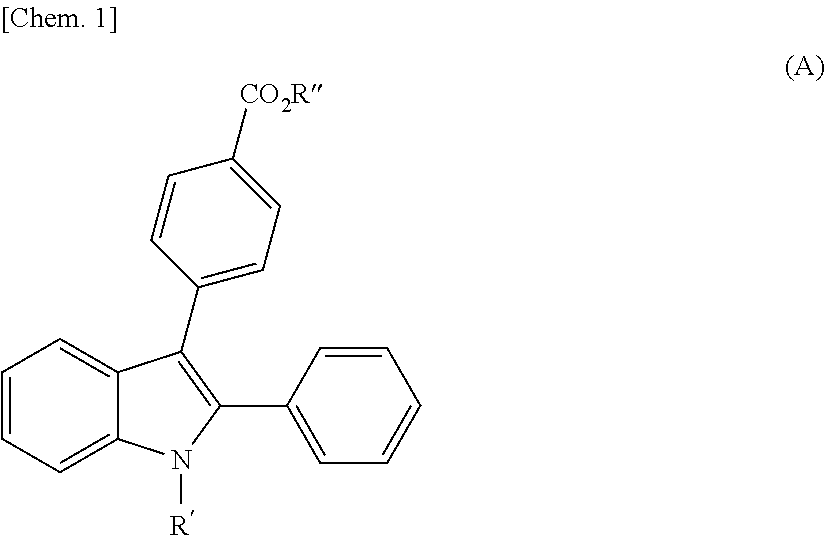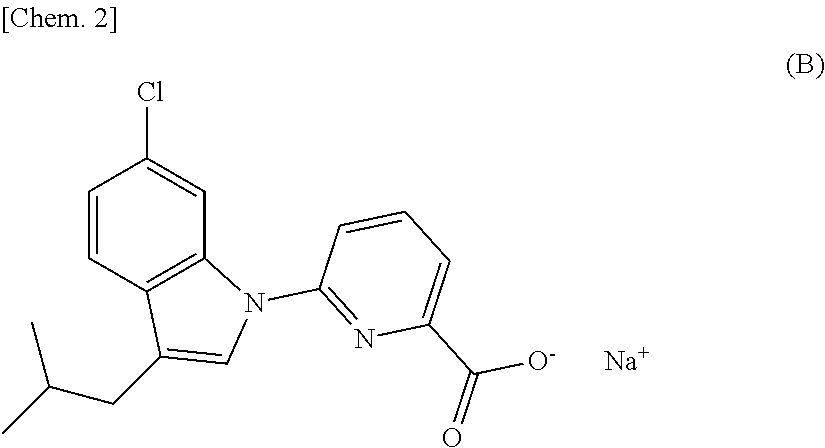Indole derivative or pharmaceutically acceptable salt thereof
a technology of indole and salt, which is applied in the field of indole derivatives, can solve the problems of not always effective for all patients and lower quality of life, and achieve the effects of treating or preventing the symptoms of lower urinary tract, and potent ep1 receptor antagonism
- Summary
- Abstract
- Description
- Claims
- Application Information
AI Technical Summary
Benefits of technology
Problems solved by technology
Method used
Image
Examples
embodiment 1
[0098]A preferable embodiment of the present invention is as follows:
[0099]Y is a methylene group;
[0100]A is a benzene ring or a pyridine ring;
[0101]R1 is a hydrogen atom;
[0102]R2 is a phenyl group or a 5-membered aromatic heterocyclic group;
[0103]R3 is a methoxy group or an ethoxy group; and
[0104]RN is a hydrogen atom.
[0105]Examples of the concrete compound included in the present embodiment include the following compounds:
[0106]6-(6-methoxy-2-phenyl-1H-indol-3-ylmethyl)pyridine-2-carboxylic acid (Example 4-1), 3-(6-methoxy-2-phenyl-1H-indol-3-ylmethyl)benzoic acid (Example 4-2), 3-(6-methoxy-2-thiophen-3-yl-1H-indol-3-ylmethyl)benzoic acid (Example 4-12), 6-(6-ethoxy-2-phenyl-1H-indol-3-ylmethyl)pyridine-2-carboxylic acid (Example 4-34), 6-(6-methoxy-2-thiophen-3-yl-1H-indol-3-ylmethyl)pyridine-2-carboxylic acid (Example 11-1), 6-[2-(3-fluorophenyl)-6-methoxy-1H-indol-3-ylmethyl]pyridine-2-carboxylic acid (Example 11-5), 6-(2-furan-3-yl-6-methoxy-1H-indol-3-ylmethyl)pyridine-2-car...
embodiment 2
[0107]Another preferable embodiment of the present invention is as follows:
[0108]Y is a methylene group;
[0109]A is a benzene ring or a pyridine ring;
[0110]R1 is a hydrogen atom;
[0111]R2 is an unsubstituted phenyl group;
[0112]R3 is a methoxy group; and
[0113]RN is a hydrogen atom.
[0114]Examples of the concrete compound included in the present embodiment include the following compounds:
[0115]6-(6-methoxy-2-phenyl-1H-indol-3-ylmethyl)pyridine-2-carboxylic acid (Example 4-1), 3-(6-methoxy-2-phenyl-1H-indol-3-ylmethyl)benzoic acid (Example 4-2), 2-fluoro-3-(6-methoxy-2-phenyl-1H-indol-3-ylmethyl)benzoic acid (Example 16-9), 6-(6-methoxy-5-methyl-2-phenyl-1H-indol-3-ylmethyl)pyridine-2-carboxylic acid (Example 16-12), 6-(5-chloro-6-methoxy-2-phenyl-1H-indol-3-ylmethyl)pyridine-2-carboxylic acid (Example 16-13), 6-(5-fluoro-6-methoxy-2-phenyl-1H-indol-3-ylmethyl)pyridine-2-carboxylic acid (Example 16-16), and 2-fluoro-5-(6-methoxy-2-phenyl-1H-indol-3-ylmethyl)benzoic acid (Example 16-18).
embodiment 3
[0116]Another preferable embodiment of the present invention is as follows:
[0117]Y is a methylene group;
[0118]A is a benzene ring or a pyridine ring;
[0119]R1 is a hydrogen atom;
[0120]R2 is a substituted phenyl group;
[0121]R3 is a methoxy group; and
[0122]RN is a hydrogen atom.
[0123]Examples of the concrete compound included in the present embodiment include the following compounds:
[0124]6-[2-(3-fluorophenyl)-6-methoxy-1H-indol-3-ylmethyl]pyridine-2-carboxylic acid (Example 11-5), 6-[2-(4-fluorophenyl)-6-methoxy-1H-indol-3-ylmethyl]pyridine-2-carboxylic acid (Example 11-13), 6-[2-(3-chlorophenyl)-6-methoxy-1H-indol-3-ylmethyl]pyridine-2-carboxylic acid (Example 11-21), 6-[6-methoxy-2-(3-methoxyphenyl)-1H-indol-3-ylmethyl]pyridine-2-carboxylic acid (Example 11-34), 6-[2-(3,4-difluorophenyl)-6-methoxy-1H-indol-3-ylmethyl]pyridine-2-carboxylic acid (Example 16-2), 6-[6-methoxy-2-(3,4,5-trifluorophenyl)-1H-indol-3-ylmethyl]pyridine-2-carboxylic acid (Example 16-6), 6-[2-(5-fluoropyridin-3...
PUM
| Property | Measurement | Unit |
|---|---|---|
| temperature | aaaaa | aaaaa |
| temperature | aaaaa | aaaaa |
| temperature | aaaaa | aaaaa |
Abstract
Description
Claims
Application Information
 Login to View More
Login to View More - R&D
- Intellectual Property
- Life Sciences
- Materials
- Tech Scout
- Unparalleled Data Quality
- Higher Quality Content
- 60% Fewer Hallucinations
Browse by: Latest US Patents, China's latest patents, Technical Efficacy Thesaurus, Application Domain, Technology Topic, Popular Technical Reports.
© 2025 PatSnap. All rights reserved.Legal|Privacy policy|Modern Slavery Act Transparency Statement|Sitemap|About US| Contact US: help@patsnap.com



